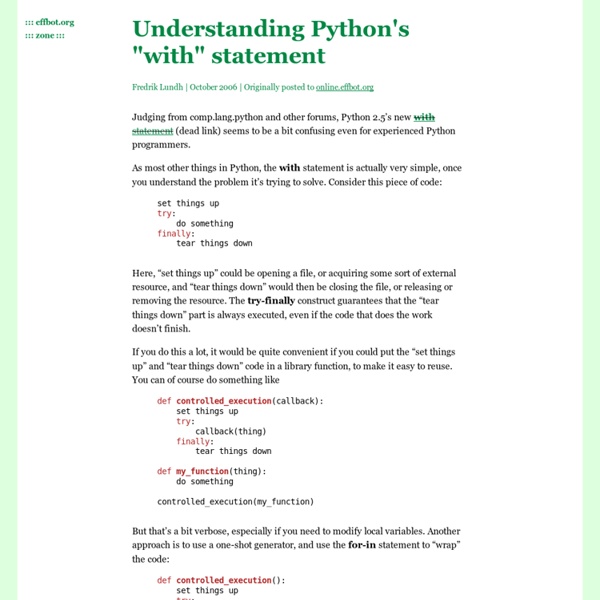HowTo/Sorting
Original version by Andrew Dalke with a major update by Raymond Hettinger Python lists have a built-in sort() method that modifies the list in-place and a sorted() built-in function that builds a new sorted list from an iterable. There are many ways to use them to sort data and there doesn't appear to be a single, central place in the various manuals describing them, so I'll do so here. Sorting Basics A simple ascending sort is very easy -- just call the sorted() function. >>> sorted([5, 2, 3, 1, 4]) [1, 2, 3, 4, 5] You can also use the list.sort() method of a list. >>> a = [5, 2, 3, 1, 4] >>> a.sort() >>> a [1, 2, 3, 4, 5] Another difference is that the list.sort() method is only defined for lists. Key Functions Starting with Python 2.4, both list.sort() and sorted() added a key parameter to specify a function to be called on each list element prior to making comparisons. For example, here's a case-insensitive string comparison: The same technique works for objects with named attributes.
5.3. Defining Classes
Python is fully object-oriented: you can define your own classes, inherit from your own or built-in classes, and instantiate the classes you've defined. Defining a class in Python is simple. As with functions, there is no separate interface definition. Just define the class and start coding. A Python class starts with the reserved word class, followed by the class name. Example 5.3. class Loaf: pass Of course, realistically, most classes will be inherited from other classes, and they will define their own class methods and attributes. Example 5.4. from UserDict import UserDict class FileInfo(UserDict): Python supports multiple inheritance. 5.3.1. This example shows the initialization of the FileInfo class using the __init__ method. Example 5.5. class FileInfo(UserDict): "store file metadata" def __init__(self, filename=None): 5.3.2. When defining your class methods, you must explicitly list self as the first argument for each method, including __init__. Whew.
Understanding Python Iterables and Iterators | Shut Up and Ship
Decorators have been in Python since version 2.4. They are the lines that start with @ symbol just before a function or a class definition. Probably you encountered them when you defined class methods, properties etc. Or perhaps you encountered them in a web framework like Django and used them to magically add login requirements for certain pages by adding a @login_required line before your view function. Decorator formalities First let us deal with the formalities like definition, syntax, etc. Here is the template of a decorator without arguments. @decoratordef F(arg): pass # is same asdef F(arg): passF = decorator(f) And here is a decorator with arguments. @decorator(n)def F(arg): pass # is same asdef F(arg): passF = decorator(n)(F) As you can see, strictly speaking we don’t need the decorator syntax. Writing our own decorators Here are a couple of functions in our module. def simpleinterest(n, p, r): return n*p*r/100.0 def compoundinterest(n, p, r): return p*(1+r/100.0)**n-p It works!
Charming Python: Iterators and simple generators
Welcome to the world of exotic flow control. With Python 2.2 (now in its third alpha release -- see Resources later in this article), programmers will get some new options for making programs tick that were not available -- or at least not as convenient -- in earlier Python versions. While what Python 2.2 gives us is not quite as mind-melting as the full continuations and microthreads that are possible in Stackless Python, generators and iterators do something a bit different from traditional functions and classes. Let's consider iterators first, since they are simpler to understand. A generator is a little more complicated and general. In some ways, a generator is like the closures which were discussed in previous installments of this column discussing functional programming (see Resources). Fortunately, using a generator is much less work than understanding all the conceptual issues of program flow and state. Taking a random walk Utilizing this function is as simple as: Back to top



